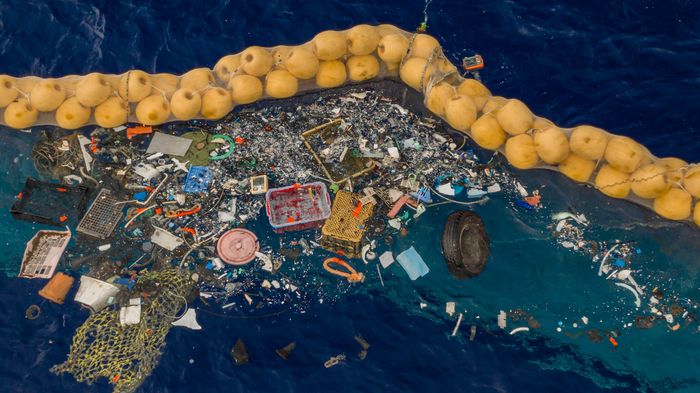
The Ocean Cleanup Successfully Catches Plastic in Great Pacific Garbage Patch
Back to pressSystem 001/B Captures Plastics in All Size Classes – from Microplastics to Ghost Nets
Rotterdam, the Netherlands – October 2, 2019 – The Ocean Cleanup, the Dutch non-profit organization developing advanced technologies to rid the oceans of plastic, announces today that its latest ocean cleanup prototype system – System 001/B – is successfully capturing and collecting plastic debris. After one year of testing, the organization’s engineers have succeeded in developing a self-contained system in the Great Pacific Garbage Patch that is using the natural forces of the ocean to passively catch and concentrate plastic, thereby confirming the most important principle behind the cleanup concept that was first presented by its founder and CEO, Boyan Slat, at a TEDx conference in October 2012.
Launched from Vancouver in June, System 001/B is The Ocean Cleanup’s second attempt to prove its concept of collecting garbage from the Great Pacific Garbage Patch, the largest accumulation zone of plastic in the world’s oceans. In addition to collecting plainly visible pieces of plastic debris, as well as much larger ghost nets associated with commercial fishing, the latest system has also successfully captured microplastics as small as 1mm – a feat the team was pleasantly surprised to achieve.
“After beginning this journey seven years ago, this first year of testing in the unforgivable environment of the high seas strongly indicates that our vision is attainable and that the beginning of our mission to rid the ocean of plastic garbage, which has accumulated for decades, is within our sights,” said Boyan Slat, Founder and CEO of The Ocean Cleanup. “Our team has remained steadfast in its determination to solve immense technical challenges to arrive at this point. Though we still have much more work to do, I am eternally grateful for the team’s commitment and dedication to the mission and look forward to continuing to the next phase of development.”
New Design Leads to Improved Performance
The aim of System 001/B was to trial modifications, which addressed known complications, primarily aimed at correcting the inconsistent speed difference between the system and the plastic. Consistency was achieved by slowing down the system with a parachute sea anchor, allowing for faster-moving plastic debris to float into the system. Once this main challenge was resolved, prominent plastic overtopping was observed – becoming the next technical challenge to solve. Due to the modularity of System 001/B, a modification to increase the size of the cork line was designed and implemented while the system was offshore. With the new cork line, minimal overtopping is now being observed, thus allowing the system to capture and concentrate plastic.
The Mission Continues
Despite the early success of System 001/B, there is still much work to do. With new learnings and experience derived from the successful deployment of System 001/B, The Ocean Cleanup will now begin to design its next ocean cleanup system, System 002; a full-scale cleanup system that is able to both endure and retain the collected plastic for long periods of time.
Once fully operational, The Ocean Cleanup will return plastic to land for recycling. Timing of that phase of the mission is contingent upon further testing and design iteration. For more information about The Ocean Cleanup, please visit: theoceancleanup.com
###
DOWNLOADS
Photos, illustrations, videos on The Ocean Cleanup from general media gallery and from the specific press kit gallery
PRESS CONTACTS
CFF Communications, Amsterdam
Niels Broekhof
press@theoceancleanup.com
T: +31(0)20 575 40 10
Shift Communications, San Francisco
Alan Dunton
press@theoceancleanup.com
T: +1 (415) 290-8219
ABOUT THE OCEAN CLEANUP
The Ocean Cleanup develops advanced technologies to rid the world’s oceans of plastic. Founded in 2013 by Boyan Slat, The Ocean Cleanup now employs approximately 90 engineers and researchers. The foundation is headquartered in Rotterdam, the Netherlands.
Instead of going after plastic debris with vessels and nets – which would take many thousands of years and billions of dollars to complete – The Ocean Cleanup plans to deploy a fleet of long floating barriers that act like an artificial coastline, enabling the winds, waves, and currents to passively catch and concentrate the plastic. Once fully operational, the full fleet of passive collection systems is expected to remove 50% of the Great Pacific Garbage Patch every five years’ time.
After years of conducting reconnaissance expeditions, scale model tests and the deployment of prototypes on the North Sea, the first ocean cleanup systems were deployed into the Great Pacific Garbage Patch in 2018 and 2019. Once The Ocean Cleanup can commence full-scale cleanup, it is scheduled to harvest over 12,000,000 kg of plastic in its first year of operation; enough to clean up half the Great Pacific Garbage Patch every 5 years. The Ocean Cleanup is working with partners to design processes to convert recovered ocean plastic into valuable raw materials and durable products.

